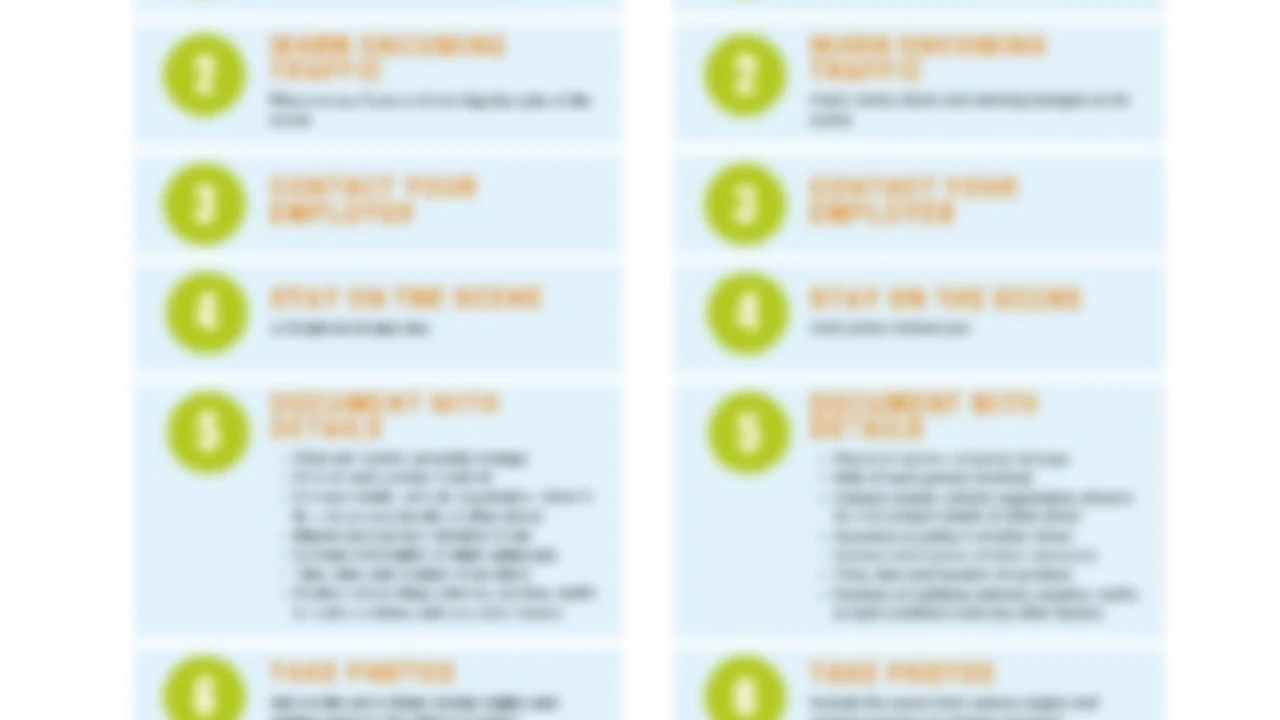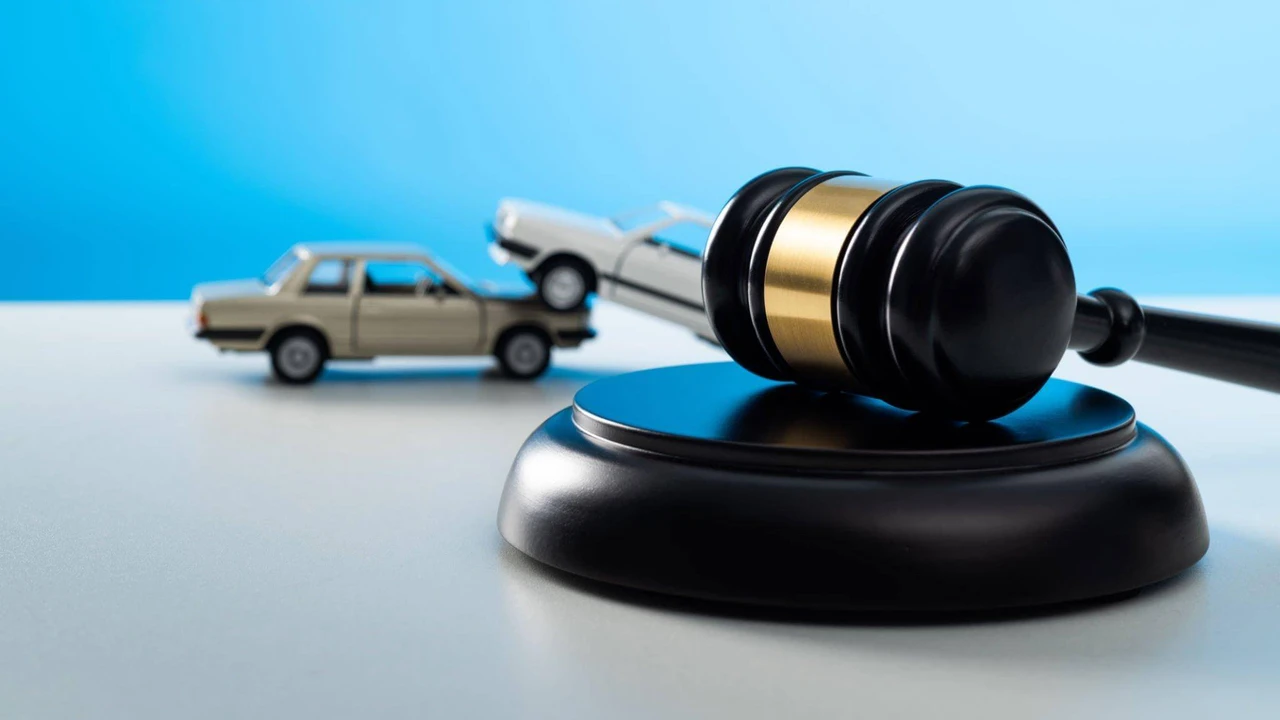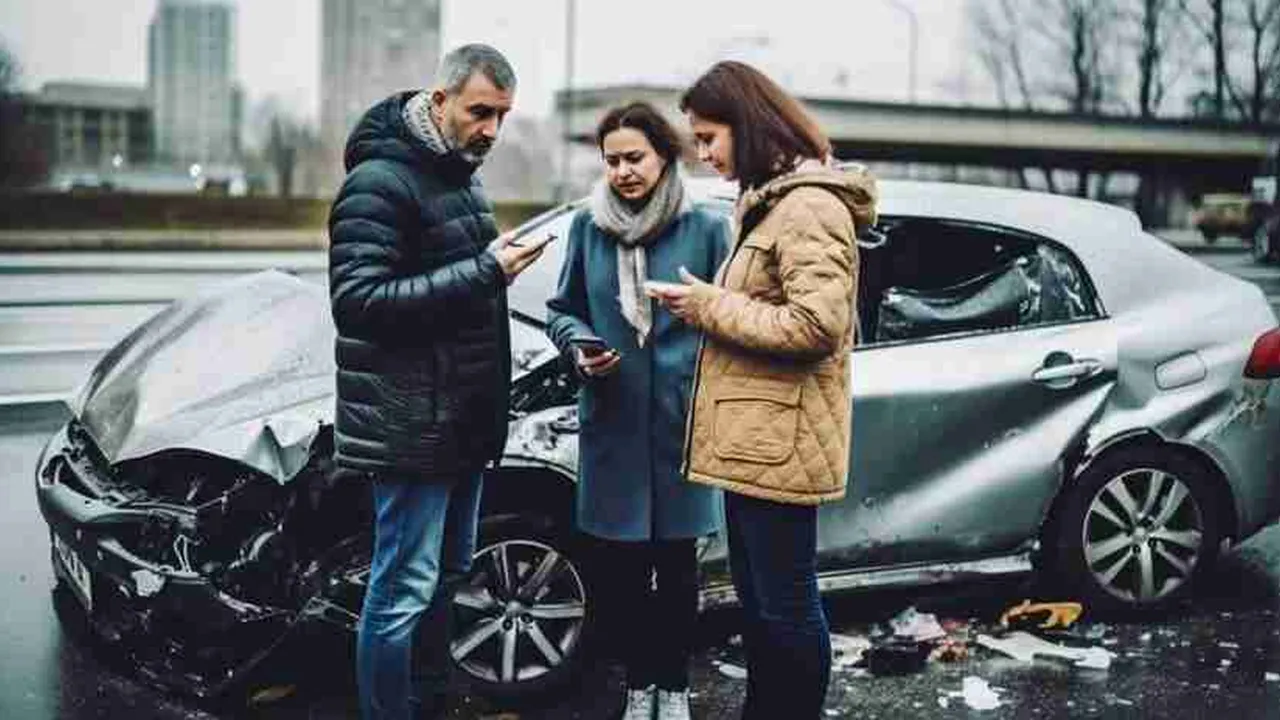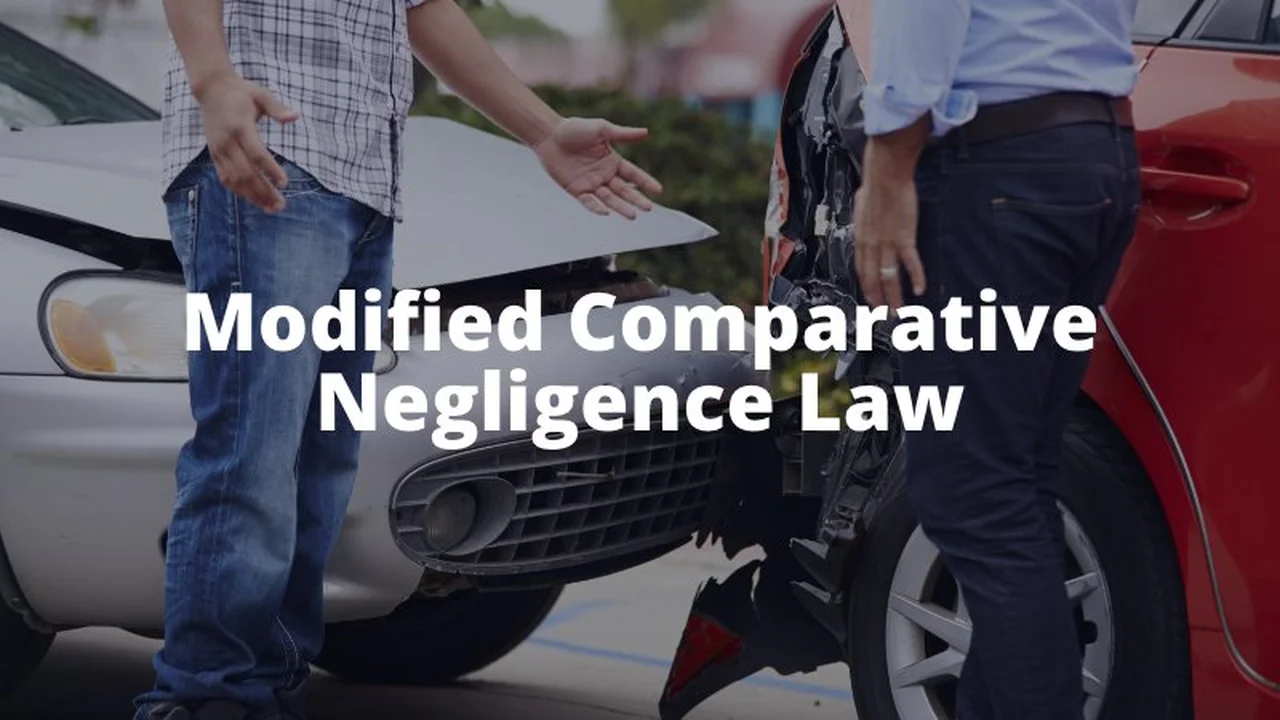Post-Accident Checklist: A Comprehensive Guide

Immediate Actions After an Accident Ensuring Your Safety and Documentation
Okay, so you've just been in an accident. First things first: breathe. Seriously. Take a deep breath. It's going to be okay. Your adrenaline is pumping, and you might be a little shaky, but the next few minutes are crucial. Let’s walk through the immediate steps you need to take to protect yourself and document everything.
Check Yourself and Others for Injuries A Priority Assessment
Before anything else, make sure you and any passengers in your car are okay. Can you move? Are you bleeding? Is anyone unconscious? If anyone is seriously injured, call 911 (or your local emergency number) immediately. Don't try to move someone who is seriously injured unless they are in immediate danger (like a car fire). And remember, even if you *feel* okay, you might have internal injuries, so it's always best to get checked out by a doctor afterward.
Move to a Safe Location Preventing Further Accidents
If your car is drivable and it’s safe to do so, move it out of the flow of traffic. Turn on your hazard lights. This is super important, especially if it's dark or visibility is poor. If you can't move your car, get yourself and your passengers to a safe location, like the side of the road or behind a guardrail. Keep an eye out for oncoming traffic!
Call the Police Reporting the Accident for Official Record
Even if the accident seems minor, it’s generally a good idea to call the police. They can create an official accident report, which will be helpful when dealing with insurance companies. The police will also help control traffic and ensure everyone's safety. When you call, be prepared to give your location, a brief description of the accident, and whether anyone is injured.
Documenting the Scene Gathering Evidence and Information
Once everyone is safe and the police are on their way (or have arrived), it's time to start documenting the scene. This is where you become a detective! The more information you gather, the better.
Exchange Information with the Other Driver Collecting Essential Details
Exchange information with the other driver(s) involved. Get their name, address, phone number, driver's license number, insurance company, and policy number. Don't get into arguments about who was at fault. Just stick to collecting the facts. If the other driver is being uncooperative or aggressive, don't engage. Let the police handle it.
Take Photos and Videos Capturing the Accident Scene and Damage
Your smartphone is your best friend here. Take lots of photos and videos of everything! Capture the damage to all vehicles involved, the position of the vehicles, any skid marks on the road, traffic signs, and the overall scene. The more visual evidence you have, the better. Make sure the photos are clear and well-lit. Videos can be helpful for showing the flow of traffic and the surrounding environment.
Gather Witness Information Securing Testimonials for Your Claim
If there were any witnesses to the accident, try to get their names and contact information. Witness statements can be incredibly valuable in determining fault. Ask them if they saw what happened and if they're willing to provide a statement to the police or your insurance company. A simple "Can I get your name and number? You saw what happened, and your statement could be helpful." will usually suffice.
Essential Tools and Products for Post-Accident Preparedness
Being prepared for an accident can make a huge difference in how smoothly things go. Here are a few products that can help you stay organized and safe:
Dash Cams Recording Video Evidence for Accident Reconstruction
A dash cam is a small camera that mounts on your dashboard and records video while you're driving. It can be invaluable in proving what happened in an accident. It provides unbiased video evidence that can be used to determine fault and protect you from false claims.
Product Recommendation: Garmin Dash Cam 67W
The Garmin Dash Cam 67W is a great option. It records in 1440p resolution, has a wide 180-degree field of view, and includes features like automatic incident detection and voice control. It's easy to install and use, and the video quality is excellent.
- Use Case: Recording driving footage, providing evidence in case of an accident, deterring aggressive drivers.
- Comparison: Compared to cheaper dash cams, the Garmin 67W offers superior video quality, a wider field of view, and more features. Compared to more expensive models, it offers excellent value for the price.
- Price: Around $250.
Product Recommendation: Vantrue N4
The Vantrue N4 is a triple dash cam, recording the front, interior, and rear of your vehicle. This is especially useful for rideshare drivers or anyone who wants comprehensive coverage.
- Use Case: Recording front, interior, and rear views, capturing incidents inside the vehicle, providing comprehensive coverage.
- Comparison: While more expensive than single-channel dash cams, the Vantrue N4 provides unparalleled coverage. It's especially beneficial in situations where determining fault is complex.
- Price: Around $300.
Emergency Roadside Kits Ensuring Safety and Assistance on the Road
An emergency roadside kit contains essential items you might need if you're stranded on the side of the road. Think jumper cables, a flashlight, a first-aid kit, and warning triangles.
Product Recommendation: AAA 42-Piece Roadside Emergency Kit
The AAA 42-Piece Roadside Emergency Kit is a well-rounded kit that includes jumper cables, a tow rope, a flashlight, a first-aid kit, and warning triangles. It's a great value for the price and provides peace of mind knowing you're prepared for common roadside emergencies.
- Use Case: Jump-starting a dead battery, providing first aid, signaling for help, towing a vehicle short distances.
- Comparison: Compared to cheaper kits, the AAA kit includes higher-quality components and a more comprehensive selection of items. Compared to more expensive kits, it offers excellent value for the price.
- Price: Around $50.
Product Recommendation: Lifeline AAA Premium Road Kit
For a more comprehensive option, consider the Lifeline AAA Premium Road Kit. It includes everything in the standard kit, plus extra items like a tire pressure gauge, a multi-tool, and emergency food and water rations.
- Use Case: All the uses of the standard kit, plus checking tire pressure, performing minor repairs, and staying hydrated and nourished in emergency situations.
- Comparison: This kit offers a higher level of preparedness for more serious roadside emergencies. The extra items can be invaluable in situations where you're stranded for an extended period.
- Price: Around $80.
Car Jump Starters Portable Power for Dead Batteries
A car jump starter is a portable battery pack that can jump-start your car without needing another vehicle. It's a lifesaver if you frequently park in areas where you might get a dead battery.
Product Recommendation: NOCO Boost Plus GB40 1000 Amp 12-Volt UltraSafe Lithium Jump Starter Box
The NOCO Boost Plus GB40 is a compact and powerful jump starter that can jump-start most vehicles up to 6 liters. It's also a power bank for charging your phone or other devices.
- Use Case: Jump-starting a dead car battery, charging mobile devices in emergency situations.
- Comparison: Compared to traditional jumper cables, the NOCO Boost Plus is much more convenient and doesn't require another vehicle. It's also safer to use, with built-in safety features to prevent sparks and reverse polarity.
- Price: Around $100.
Product Recommendation: Clore Automotive Jump-N-Carry JNC660 1700 Peak Amp 12V Jump Starter
For larger vehicles or those needing more power, the Clore Automotive Jump-N-Carry JNC660 is a more robust option. It delivers 1700 peak amps and is designed for professional use.
- Use Case: Jump-starting larger vehicles, providing reliable power for professional mechanics and roadside assistance.
- Comparison: While larger and more expensive than the NOCO Boost Plus, the JNC660 provides significantly more power and is built for heavy-duty use.
- Price: Around $200.
Dealing with Insurance Companies Navigating the Claims Process
After the initial shock of the accident wears off, you'll need to deal with insurance companies. This can be a frustrating process, but being prepared can make it a little easier.
Contact Your Insurance Company Reporting the Accident Promptly
Contact your insurance company as soon as possible after the accident. Provide them with all the details of the accident, including the other driver's information, the police report number, and photos and videos of the damage. Be honest and accurate in your reporting.
Understand Your Policy Coverage Knowing Your Rights and Limitations
Review your insurance policy to understand your coverage. What are your deductibles? What types of damage are covered? Are you covered for rental cars? Knowing your policy will help you navigate the claims process more effectively.
Document All Communication Maintaining Records for Future Reference
Keep a record of all communication with the insurance company, including dates, times, names of representatives you spoke with, and summaries of the conversations. This will be helpful if you need to dispute a claim or escalate the issue.
Consider Legal Counsel Seeking Professional Advice When Necessary
If you're seriously injured in the accident or if the insurance company is denying your claim, consider consulting with an attorney. An attorney can help you understand your legal rights and represent you in negotiations with the insurance company.
Following Up on Medical Care Prioritizing Your Health and Well-being
Your health should be your top priority after an accident. Even if you feel okay, it's important to get checked out by a doctor. Some injuries, like whiplash, can take days or weeks to manifest.
Seek Medical Attention Promptly Getting a Professional Evaluation
See a doctor as soon as possible after the accident. Explain to them what happened and any symptoms you're experiencing. They can perform a thorough examination and order any necessary tests.
Follow Your Doctor's Instructions Adhering to Treatment Plans for Recovery
Follow your doctor's instructions carefully. Take any prescribed medications, attend physical therapy appointments, and avoid activities that could aggravate your injuries. Your health is worth the investment of time and effort.
Keep Records of Medical Expenses Documenting Costs for Reimbursement
Keep records of all your medical expenses, including doctor's bills, hospital bills, prescription costs, and therapy costs. You'll need these records when filing a claim with your insurance company or seeking compensation from the other driver.
Staying Calm and Collected Maintaining Emotional Well-being
Being in an accident is stressful. It's important to take care of your emotional well-being as well as your physical health.
Acknowledge Your Feelings Recognizing and Addressing Emotional Distress
It's normal to feel anxious, stressed, or even traumatized after an accident. Acknowledge your feelings and don't try to suppress them. Talk to a friend, family member, or therapist about what you're going through.
Practice Self-Care Techniques Prioritizing Mental and Physical Relaxation
Engage in self-care activities that help you relax and de-stress. This could include taking a bath, reading a book, listening to music, or spending time in nature. Make time for yourself, even if it's just for a few minutes each day.
Seek Professional Support Consulting Therapists or Counselors if Needed
If you're struggling to cope with the emotional aftermath of the accident, consider seeking professional support. A therapist or counselor can help you process your feelings and develop coping mechanisms.
Remember, being prepared and staying calm can make a huge difference in how you handle the aftermath of an accident. Take a deep breath, follow these steps, and you'll be well on your way to recovery.
:max_bytes(150000):strip_icc()/277019-baked-pork-chops-with-cream-of-mushroom-soup-DDMFS-beauty-4x3-BG-7505-5762b731cf30447d9cbbbbbf387beafa.jpg)






